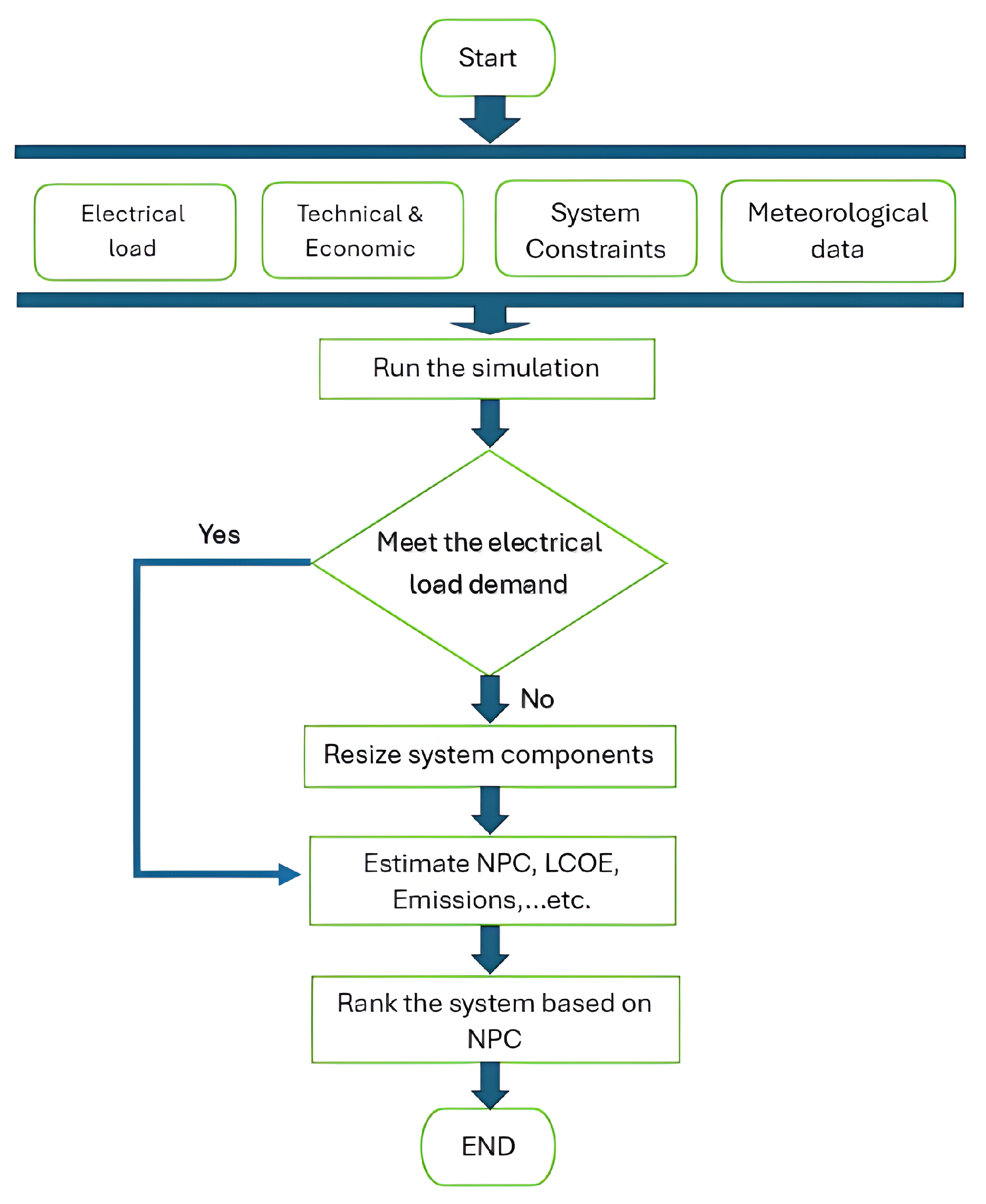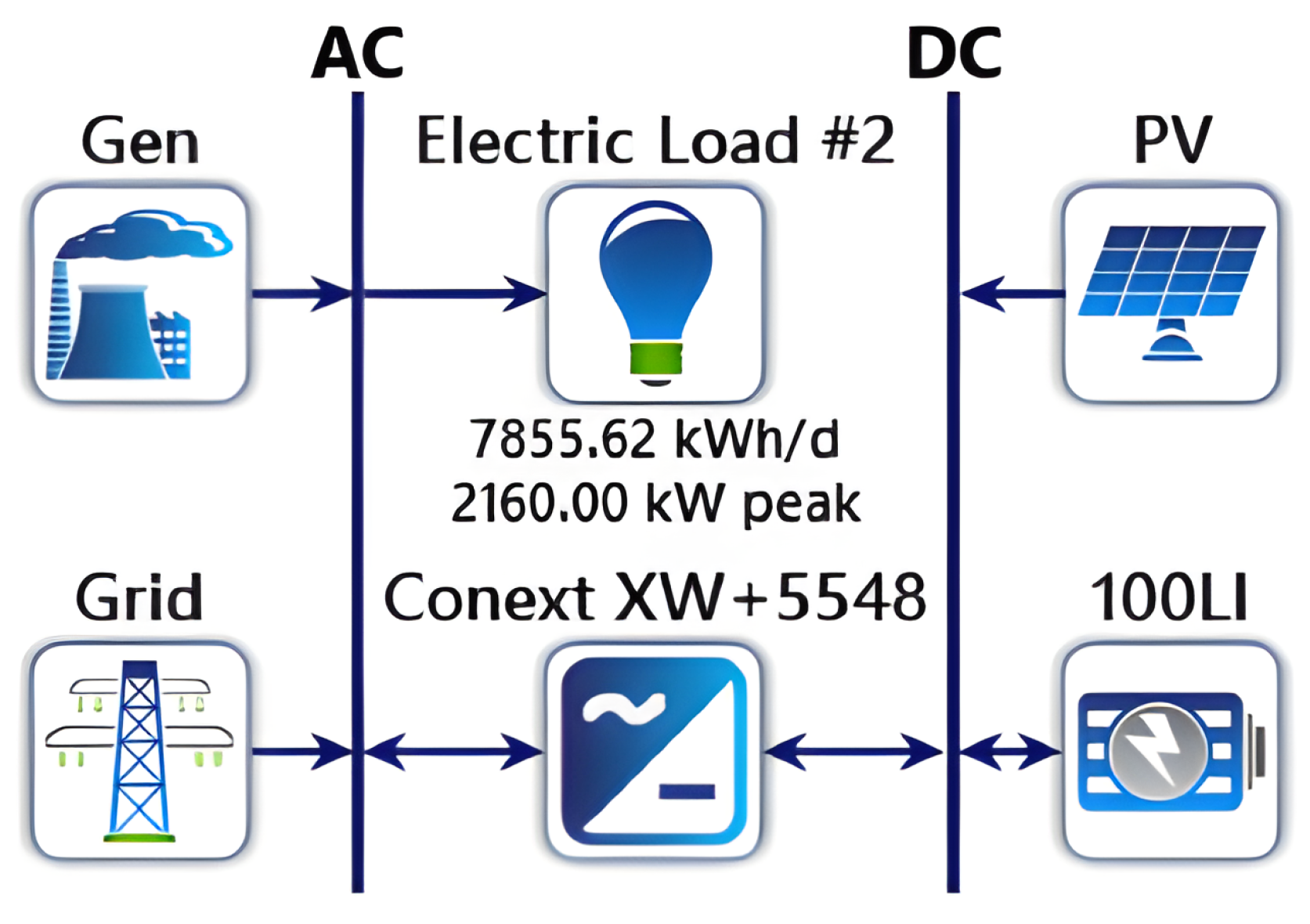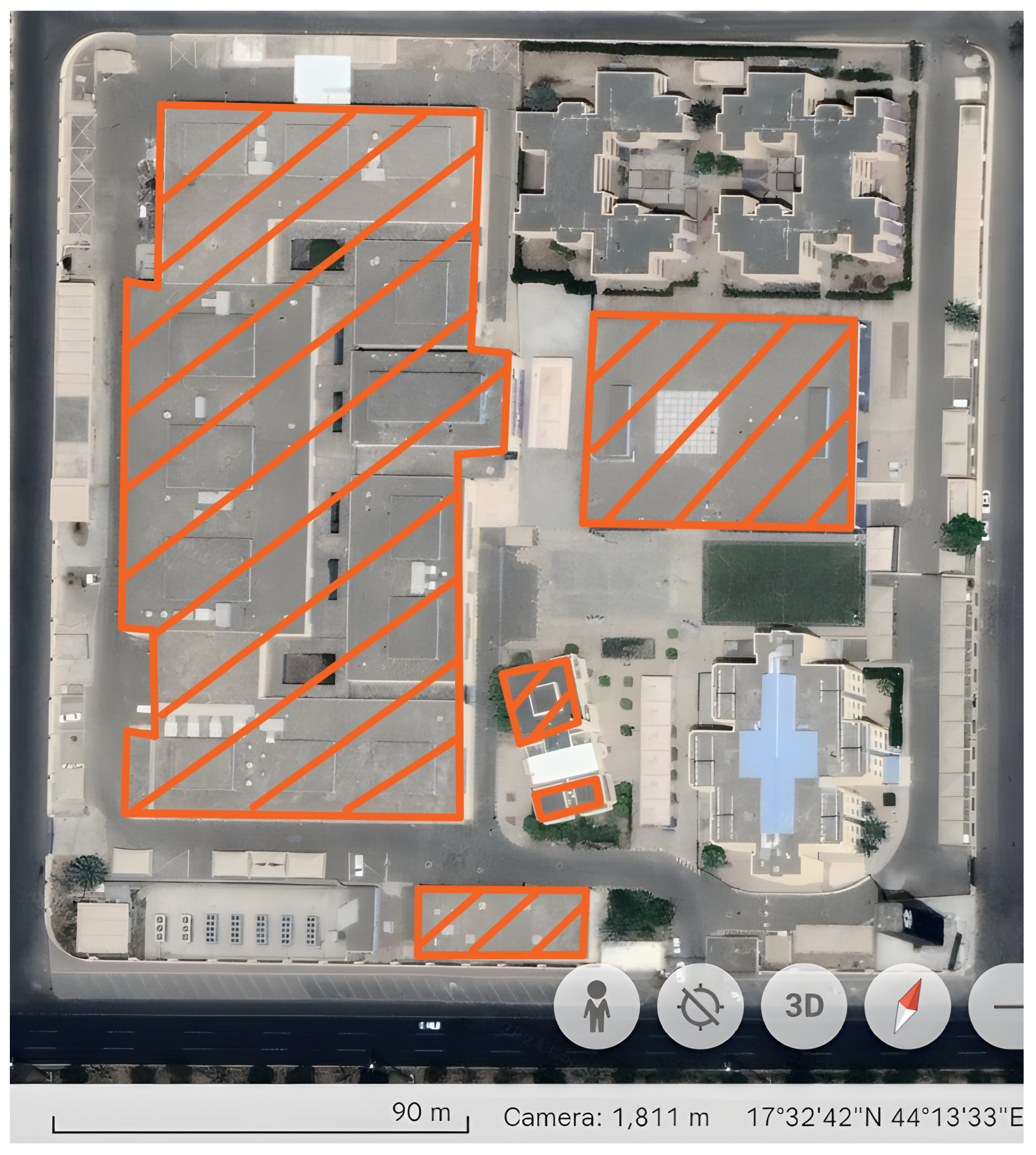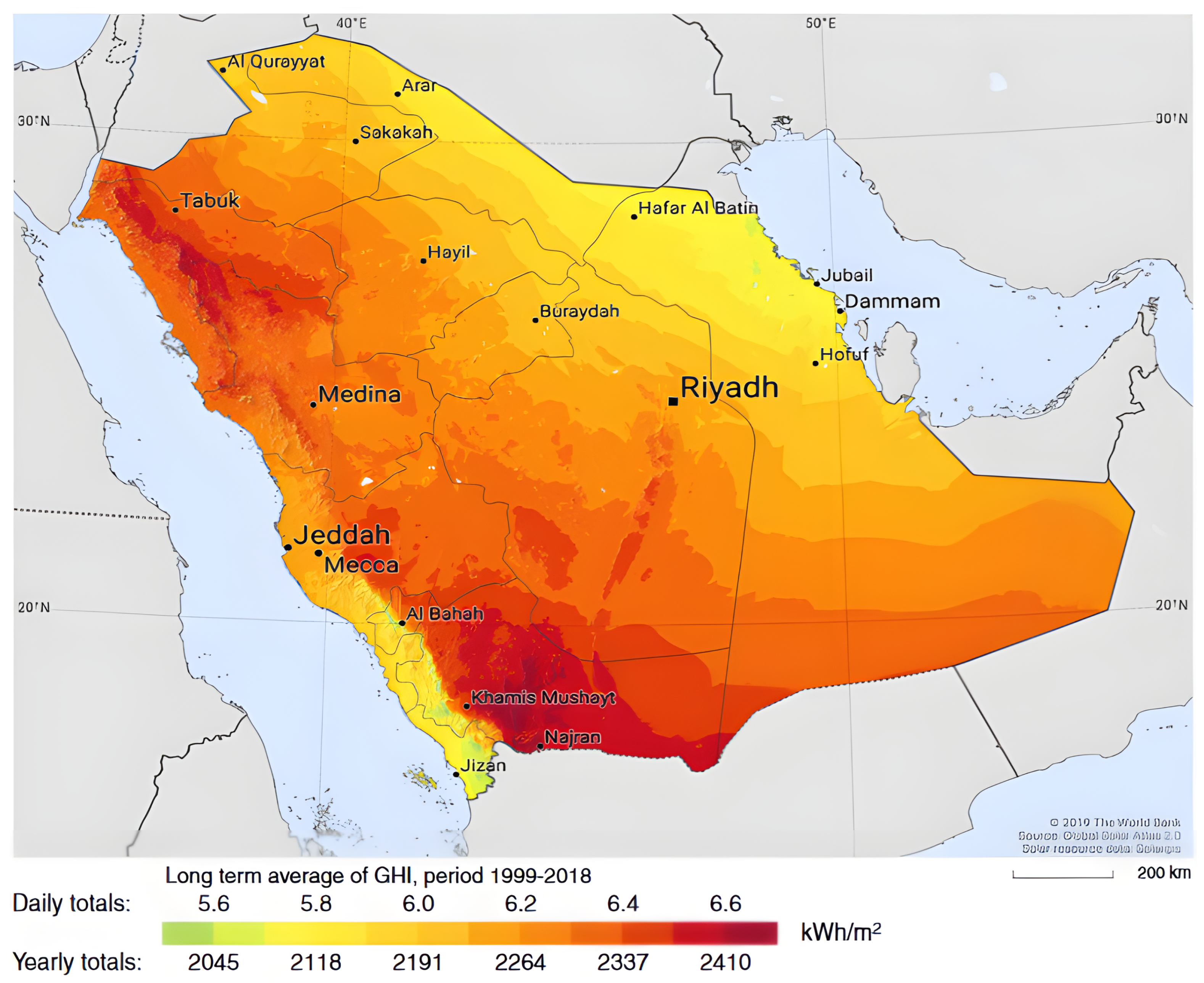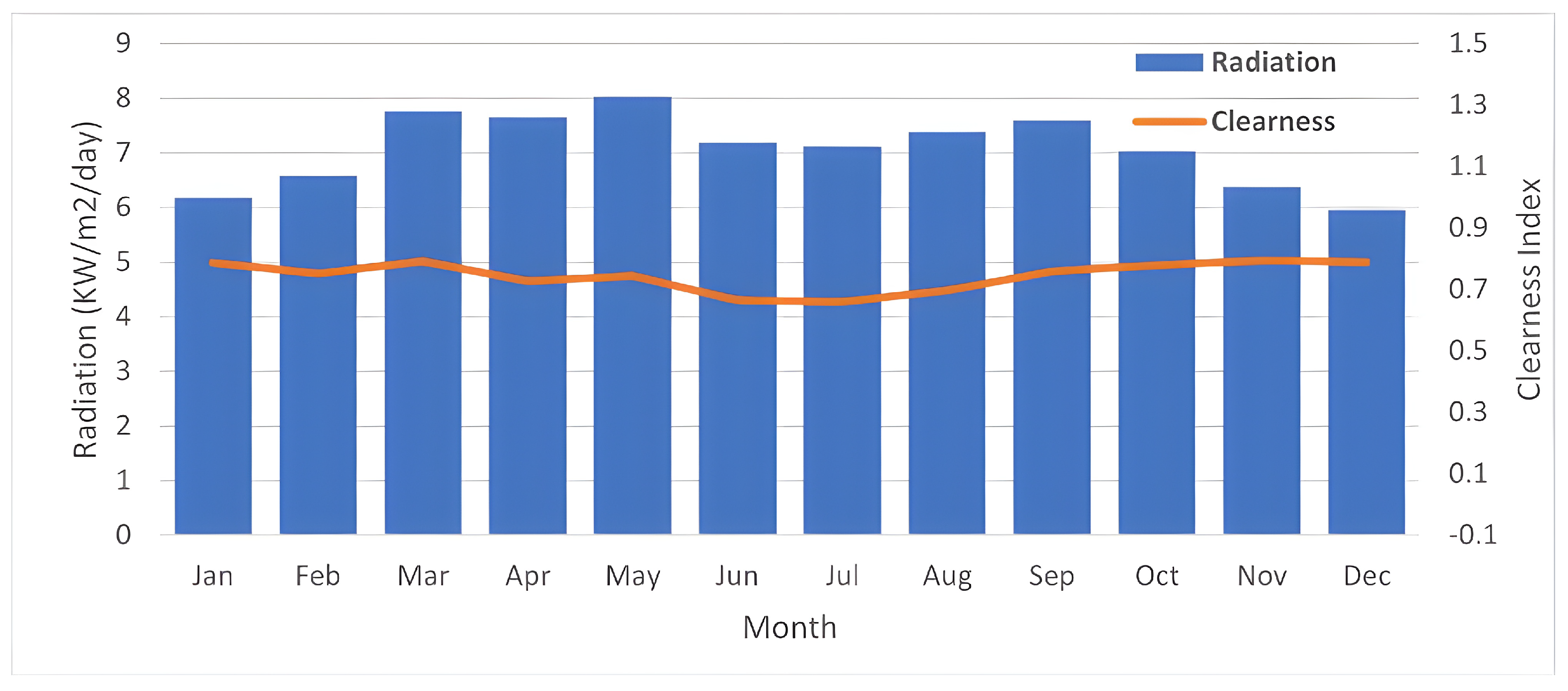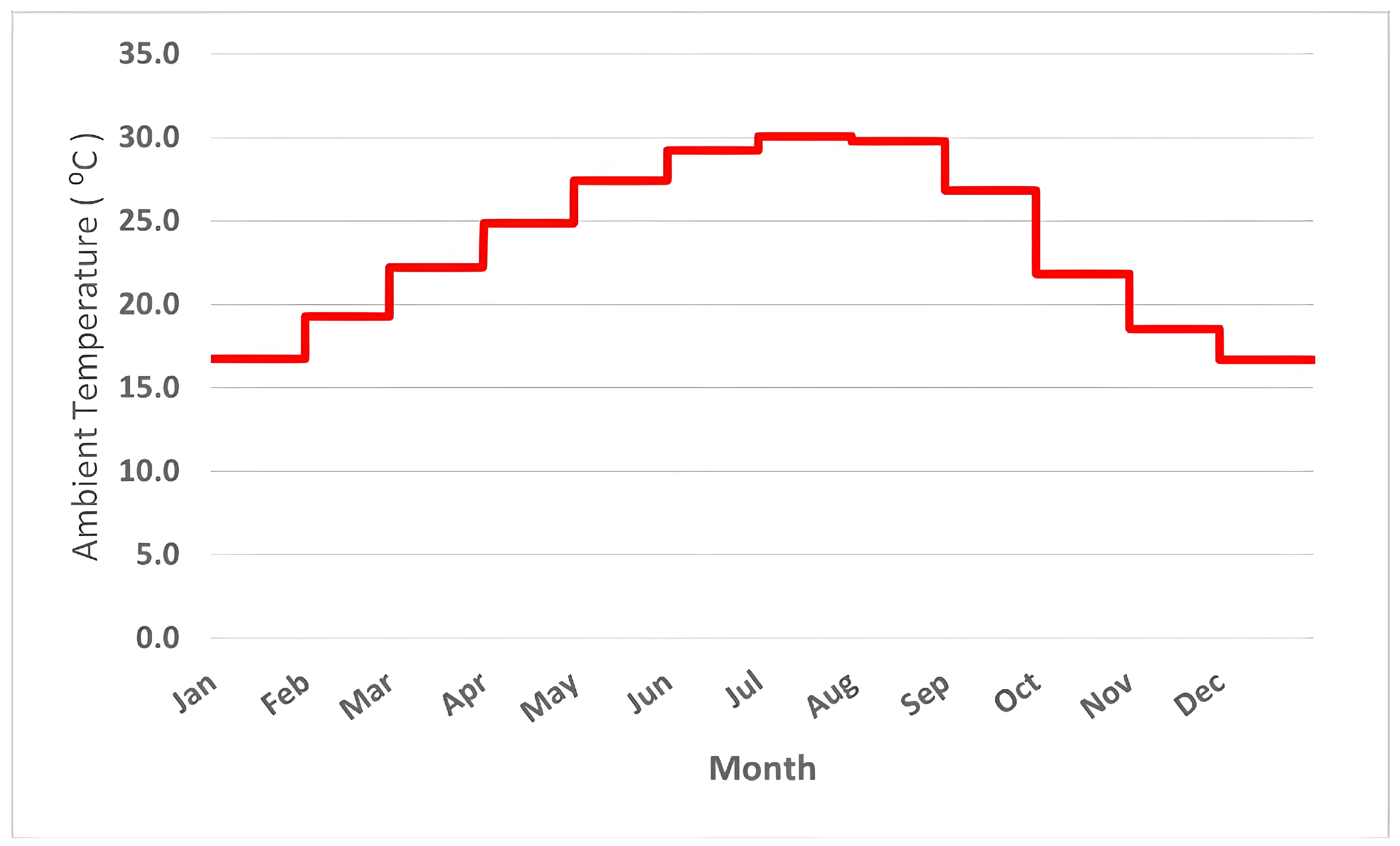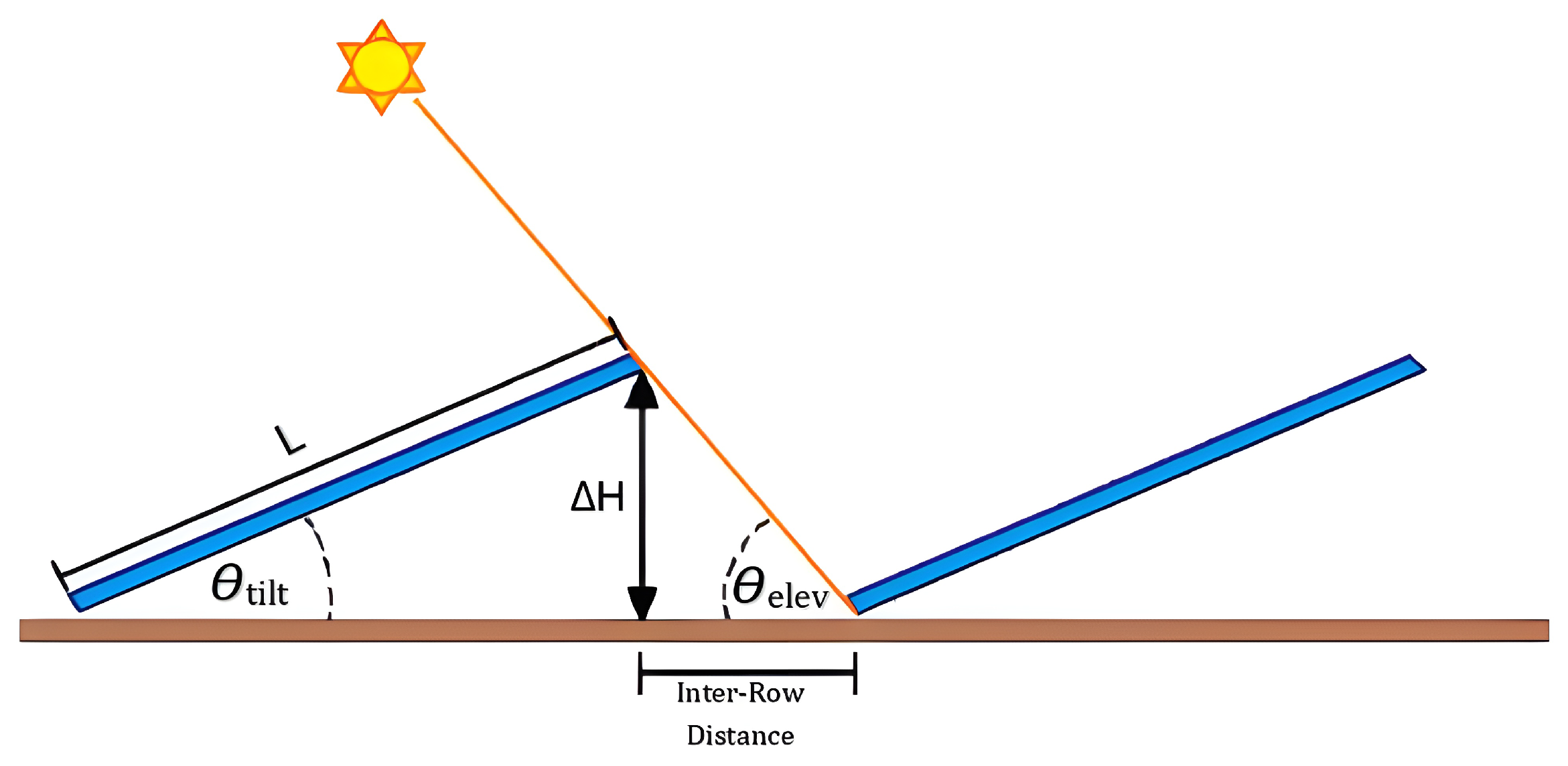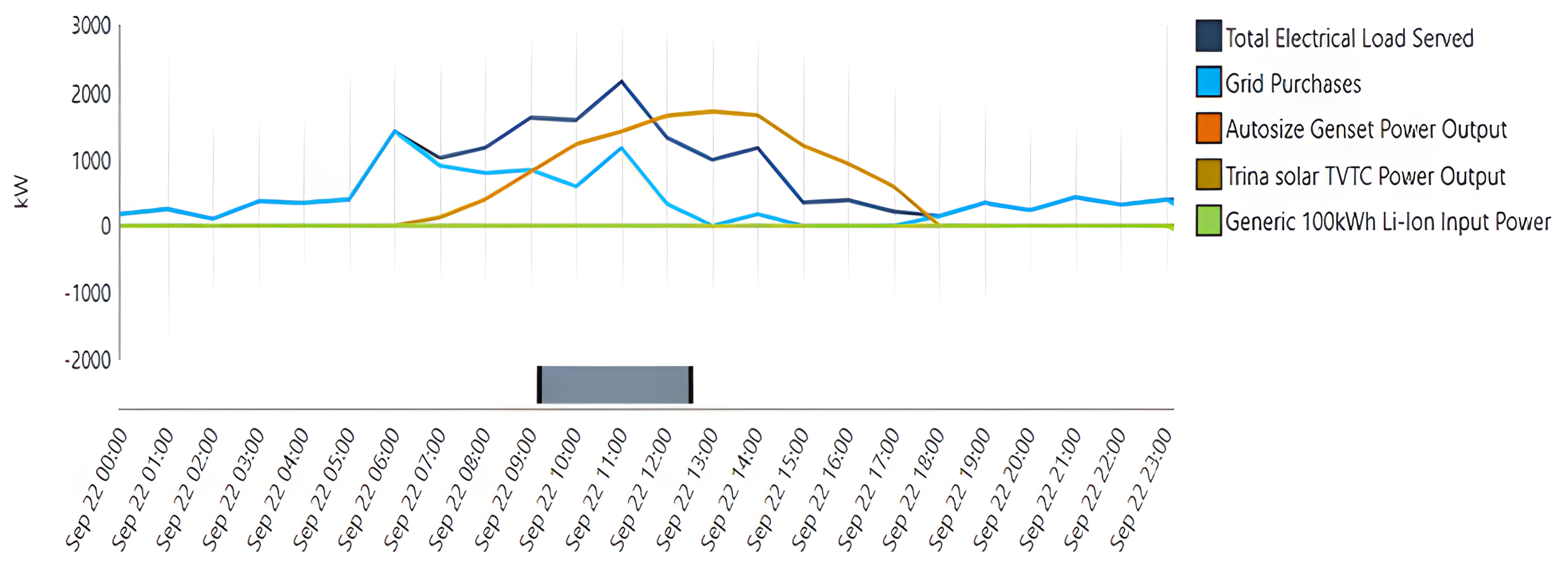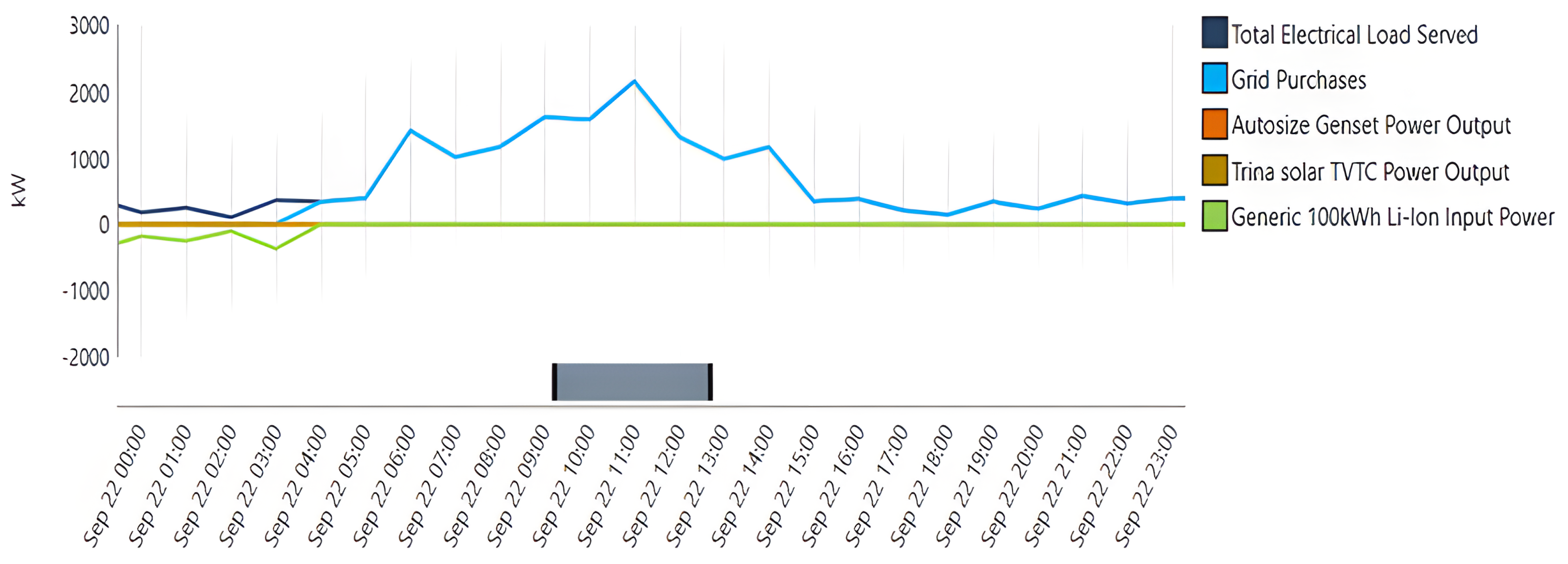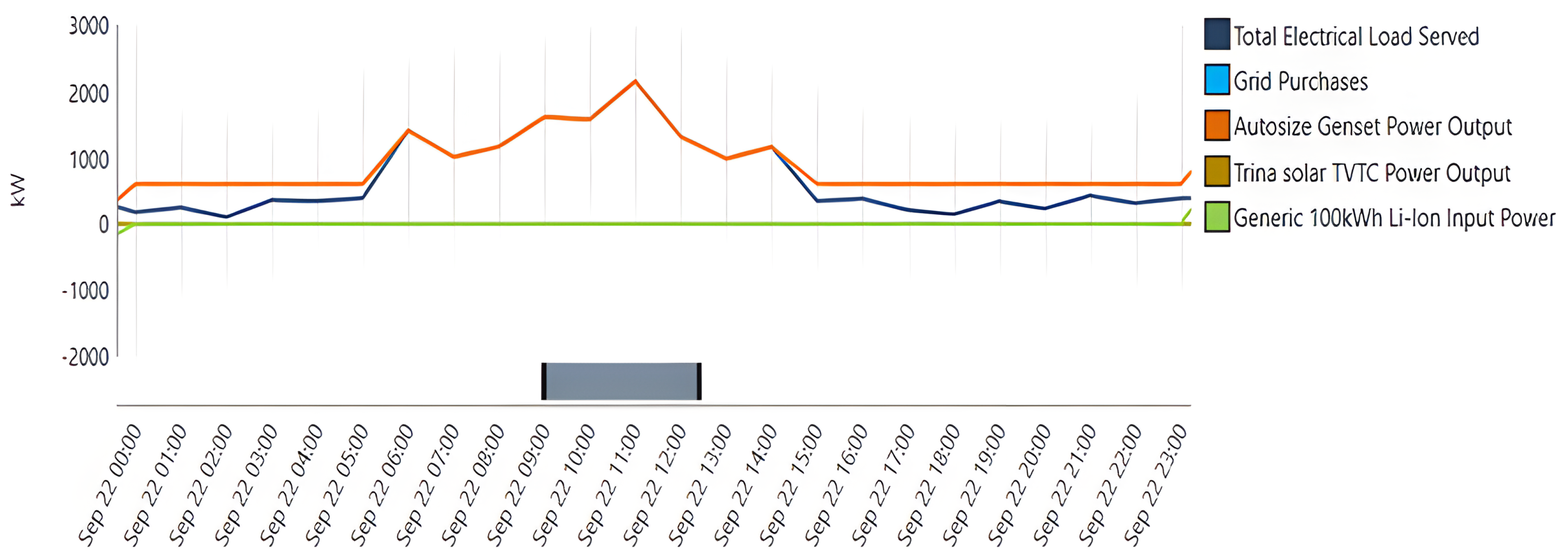1. Introduction
The global rise in demand for power due to globalization has led to an increased reliance on diverse power sources, which has required the addressing of environmental challenges like reducing carbon dioxide (CO
2) emissions and its associated costs. This underscores the importance of microgrids (MGs) as a sustainable solution. Saudi Arabia is unique in its direct use of crude oil for power generation, with nearly 60% of its electricity coming from oil, while the remainder is sourced from natural gas, as shown in
Figure 1. The power generation sector, with other energy sectors, contributed to CO
2 emissions rising by 300% between 1990 and 2019 [
1]. Despite this reliance on fossil fuels, the country possesses significant untapped potential in renewable energy sources, including solar, wind, geothermal, and waste-to-energy resources. This potential represents a compelling opportunity for Saudi Arabia to diversify its energy mix and reduce its carbon footprint in line with global sustainability goals [
2]. Saudi Arabia’s Vision 2030 focuses on the growth of energy and the expansion of non-associated natural gas. The goal is to decrease the country’s dependence on oil (including natural gas) in favor of generating electricity using preferable (i.e., renewable) sources. The Saudi National Renewable Energy Program (NREP) aims to achieve 50% of the nation’s electricity generation from renewables by 2030 [
3,
4]. The NREP consists of 13 projects, with a combined capacity of 4870 MW. Solar energy dominates, accounting for 91.8% of this total, with wind energy accounting for the remaining 8.2%. By 2024, these projects aim to produce a total of 15,108,701 MWh of electricity per year, which is enough to cover the electricity demand for 692,557 households. These projects assume a reduction in fossil fuel consumption that will lead to an annual decrease of approximately 9,828,156 tons in CO
2 emissions by 2024 [
5]. The Kingdom of Saudi Arabia is working to lead the global energy sustainability campaign to reach net zero greenhouse gas emissions by 2060.
In this study, the underutilization of renewable resources in Saudi Arabia, with a case study on the Najran Secondary Industrial Institute (NSII), is investigated by an in-depth analysis of a hybrid MG system at NSII, exploring six cases with varying tilt and azimuth angles. A benchmark study of the optimal angles against Hybrid Optimization of Multiple Energy Resources (HOMER) software defaults was conducted. Considering the NSII’s roof area constraints, an approach ensuring a reliable power supply is presented for the selected model that balances technological and economic viability with environmental considerations.
2. Literature Review
The case study in [
7] involved designing a solar photovoltaic (PV) microgrid for a hospital in Dhaka. The electrical load and solar profiles were assessed. An optimization problem minimizing cost and emissions while maximizing reliability was solved using HOMER software. In reference [
8], amid Saudi Arabia’s escalating energy demands, the authors evaluated a grid-connected PV–wind system for a 15,000 kWh/day community electrical load. Using HOMER software and King Abdullah City for Atomic and Renewable Energy (KACARE) data, four cities were assessed, with Yanbu proving the most viable, with minimal costs and emissions, thereby suggesting a global potential for similar climates. Alhawsawi, in [
9], used HOMER to design optimal hybrid renewable energy systems for an MG at Oakland University, whereby meeting unmet electrical loads and reducing greenhouse gas emissions were emphasized. The systems incorporated solar PV, energy storage system (ESS), combined heat and power (CHP), and wind turbines (WT), thus aiming for flexibility and scalability. The results showcased a sustainable energy solution with a peak electrical load of 9.958 MW, a net present cost (NPC) of USD 30M, and a levalized cost of energy (LCOE) at 0.00274 USD/kWh. The authors of [
10] found that integrating renewable energy sources (RESs), specifically solar PV and wind energy, helped with achieving strategic objectives in Saudi Arabia. An optimal MG system for the Islamic University of Madinah was studied with the following three alternatives analyzed: PV, WT, and hybrid systems. Using real weather data, the results indicated that the PV system could provide up to 3.03% of the university’s annual electrical consumption with an LCOE of 0.051 USD/kWh. The WT and hybrid options had different benefits and costs, but all contributed to reducing emissions, thus aligning with Saudi Arabia’s strategic goals. To address the challenges posed by an increasing number of electric vehicles, specifically their energy sourcing and grid load, the researchers used HOMER software. A PV–WT hybrid energy-charging station was designed and optimized with applicability for worldwide use. The best solution comprised 44.4% wind and 55.6% solar energy, which produced an annual electricity of 843,150 kWh at a cost of 0.064 USD/kWh [
11]. The authors of [
12] conducted a study focusing on New Sohag University in Egypt, and two MG systems based on renewable energy sources were compared. The first system comprised PV, a diesel generator (DG), and a converter. The second improved on this by incorporating ESS, including batteries for long-term storage and flywheels for short-term use. Utilizing HOMER software, the economic and environmental outcomes of both systems were assessed, including the costs, CO
2 emissions, and degree of diesel consumption. Dahiru et al. [
13], utilized HOMER for a techno-economic evaluation in various tropical regions in order to conduct a performance analysis of renewable-energy-based distributed grids. Specifically, in the Sudan Savannah region of Nigeria, six scenarios with grid-connected nanogrids were proposed to meet a daily residential demand of 355 kWh and a per capita energy consumption of 150 kWh. The outcomes demonstrated an LCOE between 0.0110 USD/kWh and 0.0095 USD/kWh, as well as an NPC between USD 366,210 and USD 288,680, as negative values, thereby indicating potential for significant grid export. Remarkably, a renewable energy fraction of up to 98% was attained with greenhouse gas emissions as low as 2328 tons/year.
Islam et al. [
14] explored the rarely investigated hybridized PV/wind/hydro system with pumped hydro storage (PHS) for community electricity demand in Newfoundland, Canada. This PHS-based hybrid system was contrasted with battery-based configurations, with comprehensive assessments of techno-economic and environmental potentials over traditional battery and diesel-only systems. The findings highlighted the hybrid system’s ability to provide electricity at a notably reduced cost (0.136 USD/kWh) compared to diesel-only setups (0.355 USD/kWh), resulting in significant diesel and CO
2 savings annually. The PHS-based hybrid demonstrated cost and energy advantages over BSS, with hydro integration further reducing energy costs by 58% compared to PV/wind/PHS alone. The authors of [
15] aimed to optimally size hybrid energy storage using a fuel cell (FC) system and supercapacitor (SC) for off-grid renewable applications, thus focusing on reliability and cost effectiveness. The optimal system, which was designed for a 20-year lifespan, consisted of 1351 kW PV panels and a 80 kW fuel cell stack, as well as other specified components, with the PV panels accounting for 98.2% of the electricity production. The NPC stood at USD 26.5M and the LCOE at 4.78 USD/kWh. A sensitivity analysis highlighted the significant impact of hydrogen storage costs on the overall system. The six cases studied in [
16] were assessed with respect to their feasibility in a hybridized energy system with PV, WT, and DGs with BSS for a remote village in northern Bangladesh. Utilizing HOMER software, the optimal system was identified, which consisted of 73 kW PV arrays, a 57 kW DG, and a 387 kWh BSS. This system, with an LCOE of 0.37 USD/kWh and an NPC of USD 357,284, reduced CO
2 emissions by approximately 62% compared to the kerosene used in the current system and 67% versus the grid system. Utilizing the advanced capabilities of HOMER software, the authors of [
17] innovatively integrated distributed and centralized generation, thereby incorporating a solar thermal system with five other technologies. Focusing on a seldom-addressed CHP microgrid design for a remote community in Newfoundland, the study found that renewable sources can supply all electric and majority thermal loads, thus proving to be more cost-effective than a diesel-only basis. A study that focused on the island of Favignana in Italy [
18] employed HOMER software to explore sustainable energy solutions, particularly in terms of evaluating the integration of hydrogen and battery storage for both electricity and public transportation through electric FC and hydrogen–compressed natural gas vehicles. The results revealed that a hybrid storage system, one that utilizes batteries and an electrolyzer, emerged as a viable option to enhance energy independence and to decarbonize the transport sector in small islands, thereby aligning with both economic and environmental sustainability objectives.
In a study by Islam [
19], the integration of a hybrid renewable energy system (HRES) in a large office building was examined in terms of minimizing grid electricity use and assessing the economic impacts of incorporating green vehicles. Utilizing HOMER software, it was found that implementing solar PV curtails grid electricity consumption by 43% and decreases the unit electricity cost by 10%, while also reducing emissions by over 90%. Another grid-connected system was introduced in [
20] as an economical and technologically advanced solution for electrifying a rural village in India, and this was achieved by focusing on the optimal sizing of an integrated renewable energy system (IRES) coupled with a grid for consistent power. Through utilizing PV, BSS, and a grid, the system design and its sensitivity, as well as techno-economic analyses, were constructed using HOMER software, and this was achieved considering various electrical load profiles via a demand response strategy. Notably, the configuration boasting LCOE and TNPC alongside the highest renewable fraction was identified as optimal, thereby ensuring minimized CO
2 emissions and demonstrating effectiveness in offering a reliable 24/7 power supply, even with restricted grid availability. A techno-economic performance study of grid-connected PV power systems across five different climate zones in China, utilizing HOMER software for evaluation, was evaluated in [
21]. Through considering aspects like monthly average electric production, economics, and environmental impact, the study underscored that grid/PV systems are technically, economically, and environmentally viable across all investigated zones.
In a study addressing the resilience of a proposed MG [
22], which encompassed PV, WT, ESS, DG, and converters, HOMER software played a crucial role in evaluating its operational robustness. Through the simulation of various challenges via randomized power outages across numerous days throughout the annual cycle, the software provided insights into the MG’s performance amidst potential real-world disruptions. Additionally, a novel resilience index was introduced, thereby offering a metric to gauge the extent of unmet electrical load demands during such perturbations. The authors of [
23] utilized HOMER software to explore the potential of significant renewable energy integration in a remote, sub-tropical island’s power system. The study focused on contrasting the hybrid MG’s benefits against a solely diesel-based configuration in terms of technical, financial, and environmental aspects. The findings revealed that the existing diesel system was economically burdensome for island inhabitants. However, a PV/wind/diesel/battery hybrid MG emerged as the most cost-effective solution, as it was notably cheaper in terms of NPC and per-unit electricity cost while achieving a 56% renewable energy share and reducing CO
2 emissions by 23%. Sawle et al. [
24] studied an electrical load around 900 kWh/d with almost 100 kW peak in Ukai City, India. In that study, HOMER software was able to determine the most feasible hybrid system from four configurations, thereby settling on a PV, WT, MH (micro hydro), converter, battery, DG, and BG (biodiesel generator) hybrid system. This system offered the lowest COE and NPC at USD 0.196 and USD 831,217, respectively. Additionally, it boasted a high renewable factor of 81.2% and fewer emissions, thus making it more environmentally friendly.
Table 1 summarizes most of the recent studies cited in this literature review.
5. Conclusions
In this study, the application of a hybrid MG system at the NSII, which is located in Najran City in the southern region of Saudi Arabia, was investigated with a focus on assessing its economic, environmental, and reliability aspects under various tilt and azimuth angles. This research contributes to the renewable energy sector in the Najran region, thereby addressing the growing demand for renewable energy sources across Saudi Arabia. A novel aspect of this study lies in the comprehensive approach it takes, whereby it integrates both innovative architectural design and effective system management for the chosen site. Additionally, the study incorporated the latest research findings to determine the optimal tilt and azimuth angles for the specific location, which was achieved by comparing them to the default angles from the HOMER software.
The proposed model selects technically and economically feasible configurations, which were achieved by analyzing environmental considerations while ensuring the reliable supply of electrical load demands within the available roof area. The study also conducted an extensive sensitivity analysis, and it assessed the system’s resilience under various scenarios.
Among the six different cases considered, the configuration in Case 6, with a tilt angle of 20.97° and an azimuth angle of 50°, emerged as the most favorable in terms of economic considerations, environmental impact, and system reliability. It achieved reductions of 54.69% in NPC and 92% in compared with the current grid-only system, all while meeting the entire electrical demand for all of the applied resilience scenarios.
In summary, this research builds upon recent studies and real input data to provide a robust and well-supported evaluation of the proposed hybrid MG system. It highlights the potential of the Najran region in contributing to Saudi Arabia’s renewable energy endeavors, and it also underscores the importance of further research and investment in this promising area.

